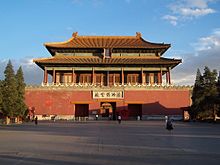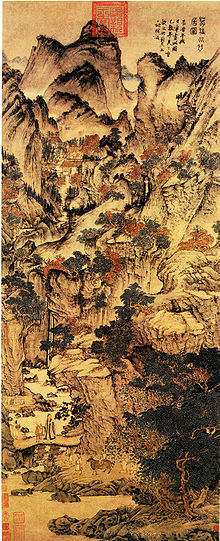Palace Museum

The art collections of the Palace Museum (Chinese: 故宫博物院; pinyin: Gùgōng Bówùyùan), a national museum housed in the Forbidden City in Beijing, China, are built upon the imperial collection of the Ming and Qing dynasties. This collection was expanded in the 20th century with new acquisitions, transfers from other museums, and new archaeological discoveries.
Site

The Palace Museum is housed in the Forbidden City, the Chinese imperial palace from the Ming Dynasty to the end of the Qing Dynasty. It is located in the middle of Beijing, China. For almost five centuries, it served as the home of the Emperor and his household, and the ceremonial and political centre of Chinese government.
Built from 1406 to 1420, the complex consists of 980 surviving buildings with 8,707 bays of rooms[1] and covers 720,000 square metres. The palace complex exemplifies traditional Chinese palatial architecture,[2] and has influenced cultural and architectural developments in East Asia and elsewhere. The Forbidden City was declared a World Heritage Site in 1987,[2] and is listed by UNESCO as the largest collection of preserved ancient wooden structures in the world.
History
Built from 1406 to 1420, the Forbidden City was the Chinese imperial palace from the early Ming Dynasty to the end of the Qing Dynasty. In 1912, Puyi, the last Emperor of China, abdicated. Under an agreement with the new Republic of China government, Puyi remained in the Inner Court, while the Outer Court was given over to public use,[3] where a small museum was set up to display artefacts housed in the Outer Court. In 1924, Puyi was evicted from the Inner Court after a coup.[4] The Palace Museum was then established in the Forbidden City on Double Ten Day (October 10), 1925.[5]

The collections of the Palace Museum are based on the Qing imperial collection. According to the results of a 1925 audit,[6] some 1.17 million items were stored in the Forbidden City. In addition, the imperial libraries housed one of the country's largest collections of ancient books and various documents, including government documents of the Ming and Qing dynasties.
From 1933, the threat of Japanese invasion forced the evacuation of the most important parts of the Museum's collection.[7] After the end of World War II, this collection was returned to Nanjing.[8] However, with the Communists' victory imminent in the Chinese Civil War, the Nationalist government under Chiang Kai-shek ordered the evacuation of the pick of this collection to Taiwan. Of the 13,427 boxes of evacuated artefacts, 2,972 boxes are now housed in the National Palace Museum in Taipei. This relatively small but high quality collection today form the core of that museum.[9] Almost ten thousand boxes were returned to Beijing, but 2,221 boxes remain today in storage under the charge of the Nanjing Museum.[9]
Under the government of the People's Republic of China, the Museum conducted a new audit as well as a thorough search of the Forbidden City, uncovering a number of important items. In addition, the government moved items from other museums around the country to replenish the Palace Museum's collection. It also purchased and received donations from the public.[10]
In recent years, the presence of commercial enterprises in the Forbidden City has become controversial.[11] A Starbucks store[12], which opened in 2000, [13] sparked objections [14] and eventually closed on July 13, 2007. Chinese media also took notice of a pair of souvenir shops that refused to admit Chinese citizens in order to price-gouge foreign customers in 2006.[15]
Collections

There are over a million rare and valuable works of art in the collection of the Palace Museum.[16][17] Art works in the Palace Museum's permanent collection total 1,052,653; these includes paintings, pottery, inscribed wares, bronze wares, and court documents.[16]
Ceramic
The Palace Museum holds 340,000 pieces of ceramics and porcelain. These include imperial collections from the Tang Dynasty and the Song Dynasty, as well as pieces commissioned by the Palace, and, sometimes, by the Emperor personally. This collection is notable because it derives from the imperial collection, and thus represents the best of porcelain production in China. The Palace Museum holds about 320,000 pieces of porcelain from the imperial collection. The rest are almost all held in the National Palace Museum in Taipei and the Nanjing Museum.
The ceramic collection of the Palace Museum represents a comprehensive record of Chinese ceramic production over the past 8,000 years, as well as one of the largest such collections in the world.[10]
Paintings


The Palace Museum holds close to 50,000 paintings. Of these, more than 400 date from before the Yuan Dynasty (1271-1368). This is the largest such collection in China and includes some of the rarest and most valuable paintings in Chinese history.[18]
The collection is based on the palace collection in the Ming and Qing Dynasties. The personal interest of Emperors such as Qianlong meant that almost all surviving paintings from the Yuan Dynasty and before were held by the palace. However, a significant portion of this collection was lost. After his abdication, Puyi transferred paintings out of the palace, and many of these were subsequently lost or destroyed. In 1948, some of the best parts of the collection were moved to Taiwan, and by 1949 the Palace Museum had less than 5,000 items, none of which dated from before the Yuan Dynasty. From that time, the collection has been gradually replenished, through donations, purchases, and transfers from other museums.
Bronzeware
Bronze holds an important place in Chinese culture, and was always an important part of state ceremony. The Palace Museum's bronze collection dates from the early Shang Dynasty (founded c. 1766 BC). Of the almost 10,000 pieces held, about 1600 are inscribed items from the pre-Qin period (to 221 BC). A significant part of the collection is ceremonial bronzeware from the imperial court, including complete sets of musical instruments used by the imperial orchestras.[19]
Timepieces
The Palace Museum has one of the largest collections of mechanical timepieces of the 18th and 19th centuries in the world, with more than 1,000 pieces. The collection contains both Chinese- and foreign-made pieces. Chinese pieces came from the palace's own workships, Guangzhou (Canton) and Suzhou (Suchow). Foreign pieces came from countries including Britain, France, Switzerland, the United States and Japan. Of these, the largest portion come from Britain.[20]
Notable pieces in the collection include a clock with an attached automaton which is able to write, with a miniature writing brush on inserted paper, an auspicious couplet in perfect Chinese calligraphy. [21]
Jade
Jade has a unique place in Chinese culture.[22] The Museum's collection, mostly derived from the imperial collection, includes some 30,000 pieces. The pre-Yuan Dynasty part of the collection includes several pieces famed throughout history, as well as artefacts from more recent archaeological discoveries. The earliest pieces date from the Neolithic period. Ming Dynasty and Qing Dynasty pieces, on the other hand, include both items for palace use, as well as tribute items from around the Empire and beyond.[23]
Palace artefacts
In addition to works of art, a large proportion of the Museum's collection consists of the artefacts of the imperial court. This includes items used by the imperial family and the palace in daily life, as well as various ceremonial and bureaucratic items important to government administration. This comprehensive collection preserves the daily life and ceremonial protocols of the imperial era.[24]
See also
References
- ^ "故宫到底有多少间房 (How many rooms in the Forbidden City)" (in Chinese). Singtao Net. 2006-09-27. Retrieved 2007-07-05.
{{cite news}}: Cite has empty unknown parameter:|coauthors=(help) - ^ a b "UNESCO World Heritage List: Imperial Palaces of the Ming and Qing Dynasties in Beijing and Shenyang". UNESCO. Retrieved 2007-05-04.
- ^ p 137, Yang (2003)
- ^ Yan, Chongnian (2004). "国民—战犯—公民 (National - War criminal - Citizen)". 正说清朝十二帝 (True Stories of the Twelve Qing Emperors) (in Chinese). Beijing: Zhonghua Book Company. ISBN 710104445X.
{{cite book}}: Unknown parameter|link=ignored (help) - ^ Cao Kun (2005-10-06). "故宫X档案: 开院门票 掏五毛钱可劲逛 (Forbidden City X-Files: Opening admission 50 cents)". Beijing Legal Evening (in Chinese). People Net. Retrieved 2007-07-25.
{{cite news}}: Cite has empty unknown parameter:|coauthors=(help) - ^
Wen, Lianxi (ed.) (1925). 故宫物品点查报告 [Palace items auditing report]. Beijing: Caretaker Committee of the Qing Dynasty Imperial Family. Reprint (2004): Xianzhuang Book Company. ISBN 7-80106-238-8.
{{cite book}}:|first=has generic name (help); Cite has empty unknown parameter:|coauthors=(help) - ^ See map of the evacuation routes at: "National Palace Museum - Tradition & Continuity". National Palace Museum. Retrieved 2007-05-01.
{{cite web}}: Cite has empty unknown parameters:|month=and|coauthors=(help) - ^ "National Palace Museum - Tradition & Continuity". National Palace Museum. Retrieved 2007-05-01.
{{cite web}}: Cite has empty unknown parameters:|month=and|coauthors=(help) - ^ a b "三大院长南京说文物 (Three museum directors talk artefacts in Nanjing)". Jiangnan Times (in Chinese). People Net. 2003-10-19. Retrieved 2007-07-05.
{{cite news}}: Cite has empty unknown parameter:|coauthors=(help) - ^ a b "北京故宫与台北故宫 谁的文物藏品多? (Beijing Palace Museum and Taipei Palace Museum: which collection is bigger?)". Guangming Daily (in Chinese). Xinhua Net. 2005-01-16. Retrieved 2007-07-05.
{{cite news}}: Cite has empty unknown parameter:|coauthors=(help) - ^ "闾丘露薇:星巴克怎么进的故宫?Luqiu Luwei: How did Starbucks get into the Forbidden City" (in Chinese). People Net. 2007-01-16. Retrieved 2007-07-25.
{{cite news}}: Cite has empty unknown parameter:|coauthors=(help); see also the original blog post here (in Chinese). - ^ Starbucks Corporation. "Starbucks Store Locator -- Store detail". Retrieved 2007-05-01.
{{cite web}}: Cite has empty unknown parameters:|month=and|coauthors=(help) - ^ Mellissa Allison (2007-07-13). "Starbucks closes Forbidden City store". The Seattle Times. Retrieved 2007-07-14.
- ^ Reuters (2000-12-11). "Starbucks brews storm in China's Forbidden City". CNN. Retrieved 2007-05-01.
{{cite news}}:|author=has generic name (help); Cite has empty unknown parameter:|coauthors=(help) - ^ "Two stores inside Forbidden City refuse entry to Chinese nationals" (in Chinese). Xinhua Net. 2006-08-23. Retrieved 2007-05-01.
{{cite news}}: Cite has empty unknown parameter:|coauthors=(help) - ^ a b "The Palace Museum". China.org. 2005-05-01.
- ^ Jackie Craven. "Forbidden City in Beijing, China". About.com: Architecture.
- ^ The Palace Museum. "Collection highlights - Paintings" (in Chinese). Retrieved 2007-07-05.
{{cite web}}: Cite has empty unknown parameters:|month=and|coauthors=(help) - ^ The Palace Museum. "Collection highlights - Bronzeware" (in Chinese). Retrieved 2007-07-05.
{{cite web}}: Cite has empty unknown parameters:|month=and|coauthors=(help) - ^ The Palace Museum. "Collection highlights - Timepieces" (in Chinese). Retrieved 2007-07-05.
{{cite web}}: Cite has empty unknown parameters:|month=and|coauthors=(help) - ^ The Palace Museum. "Gilded copper clock with the decoration of writing person" (in Chinese). Retrieved 2007-07-05.
{{cite web}}: Cite has empty unknown parameters:|month=and|coauthors=(help) - ^ Laufer, Berthold (1912). Jade: A Study in Chinese Archeology & Religion. Gloucestor MA: Reprint (1989): Peter Smith Pub Inc. ISBN 978-0844652146.
{{cite book}}: Cite has empty unknown parameter:|coauthors=(help) - ^ The Palace Museum. "Collection highlights - Jade" (in Chinese). Retrieved 2007-07-05.
{{cite web}}: Cite has empty unknown parameters:|month=and|coauthors=(help) - ^ The Palace Museum. "Collection highlights - Palace artefacts" (in Chinese). Retrieved 2007-07-05.
{{cite web}}: Cite has empty unknown parameters:|month=and|coauthors=(help)
External links
